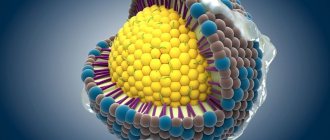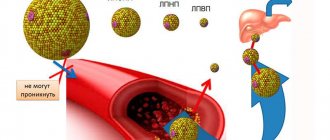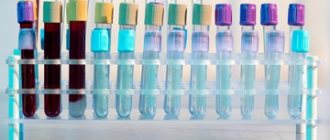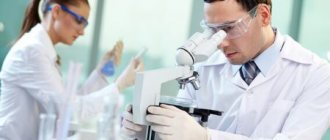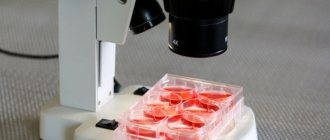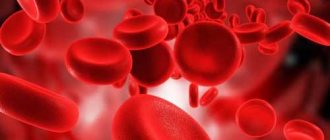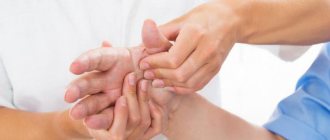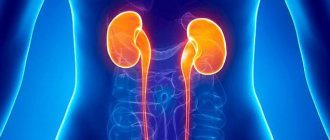Metabolism or exchange of substances occurs constantly in the body. This is not a single process, but rather a group of natural phenomena. They ensure normal life activities.
A special case is the so-called lipid metabolism. In other words, fat. Accumulation and burning. Normally, such processes are balanced. Therefore, a person does not gain excess weight. Special substances play a big role in this matter.
HDL is one such compound, the acronym stands for high-density lipoprotein. Despite the fact that these chemical active substances are smaller in size than others, they play a major antiatherogenic role. That is, they reduce the concentration of cholesterol and allow the body to function normally. The likelihood of atherosclerosis also decreases.
We can say that high-density lipoproteins are welcome guests in the human body. Therefore, you need to strive to increase this “good” cholesterol. The name is not entirely accurate, but reflects the essence of the connection and its function.
What else do patients need to know about high-density lipoproteins? It is necessary to understand the issue in more detail.
How to increase good cholesterol
About 70% of LDL circulates in the blood, the remainder being HDL.
With normal levels of high-density lipoprotein, excess bad cholesterol is transported from cells to the liver for excretion. When the level of good cholesterol decreases, the damaged endothelium (the inner lining of blood vessels) is filled with particles of saturated LDL. Over the years, atherosclerotic plaques form, which partially or completely block the blood flow.
The pathological process is initially asymptomatic, changes are noticeable only when receiving the result of a blood test with a low HDL content.
Based on the data, the attending physician recommends and prescribes a set of non-drug measures. Complete lifestyle changes can raise the level of good cholesterol in the blood.
Diet
A person gets most of their cholesterol from food, so it is necessary to follow a therapeutic diet.
For a low-cholesterol diet you need:
- Eliminate or sharply limit the consumption of animal fats (red meat, lard, butter, eggs).
- Do not exceed daily caloric intake (less than 2500 kcal).
- Switch to foods with monounsaturated and polyunsaturated lipids (fish and seafood, vegetable oils, nuts).
- Eat enough fiber-rich vegetables and fruits.
- Add cereal bran to your diet daily.
Complete cessation of bad habits
Nicotine damages the inner surface of the arteries, where cholesterol-laden particles tend to penetrate.
Alcoholics develop fatty hepatosis and cirrhosis. Damaged hepatocytes are not able to produce these lipoproteins, and lipid metabolism is disrupted.
Weight loss
Body mass index should not exceed 25. Studies have shown that for every 2.2 kg of weight lost, HDL cholesterol increases by 0.35 mg/dl.
Sports and exercise
Physical activity puts the necessary stress on the heart muscle, circulatory system and can increase HDL naturally.
The frequency of testing depends on the person’s health status. If factors are present that increase the risk of cardiovascular complications, tests are done regularly. The lipid status of males over 45 years of age and females over 55 years of age is subject to mandatory monitoring.
How to properly prepare for a lipid test
As a rule, the amount of HDL cholesterol is determined as part of a comprehensive biochemical analysis of the lipid profile / blood spectrum (fasting, with blood sampling from a peripheral vein). The research method used is colorimetric/photometric. Blood donation is carried out exclusively in the morning (from 8.00 to 10.00). To ensure maximum/reliable results, you must adhere to the following recommendations:
- 9-12 hours before donating venous blood, you will need to “fast” (allowed - only water, of course, not carbonated / and not sweet, i.e. regular - clean);
- However, according to the decision of the attending physician, a complete refusal to eat may not be necessary at all, as is the case with young people who do not have risk factors;
- 30 minutes before the start of the study, it is advisable to completely eliminate: smoking, physical activity, as well as emotional stress (calm down, relax, remember something good);
- Be sure to tell your doctor if you are taking dietary supplements (BAS), vitamins, hormonal contraceptives, or anabolic steroids. In general, drugs that INCREASE CHOLESTEROL and triglycerides in the blood plasma
. Perhaps your treating specialist will advise you to postpone taking them 2-3 days before taking a blood test.
Weight loss
Every extra kilogram negatively affects not only your well-being, but also the balance of different types of cholesterol in the blood.
If you maintain your ideal weight, the amount of low-density cholesterol will decrease, thereby increasing high-density cholesterol.
Very important for weight loss:
- start eating healthy and rationally;
- do not forget about daily physical activity.
If the body mass index is below 25 points, then this can be called the optimal indicator.
An excellent option would be to get into the habit of walking outdoors for at least 30 minutes every day. If the treating doctor allows it, then it will be useful to visit the gym or dance classes, plus eat only foods that remove cholesterol from the body.
If HDL is elevated what does it mean?
An increase in HDL levels is usually considered a good sign and is regarded as an antiatherogenic factor, that is, a factor that prevents the development of atherosclerosis and related cardiovascular diseases. However, there are certain pathological conditions that can also lead to increased HDL levels. This:
- Primary hyper-alpha-lipoproteinemia is a hereditary disease,
- chronic hepatitis,
- biliary cirrhosis of the liver.
An increase in HDL levels is caused by a decrease in body weight in overweight people, various stressful conditions, and also alcoholism. That is why the deviation of HDL from the norm, even in a positive direction, requires additional study of the reasons that led to this phenomenon.
Quitting bad habits
This category should include:
Quitting smoking cigarettes will help normalize your cholesterol levels. Already 14 days after quitting the bad habit, there will be a positive trend in the blood test for cholesterol, so this simple method, quitting smoking, really helps increase the level of good cholesterol.
It would be wrong to assume that a non-smoker is completely safe. Passive smoking can also cause cholesterol problems in both adults and children.
Statistics show that each pack of cigarettes smoked can reduce high-density cholesterol levels by approximately 3.5 mg/dL. As soon as a sick person gives up smoking, he will almost instantly begin to improve the condition of his blood.
People who drink alcohol in strictly moderate doses can expect an increase in HDL levels. We are talking about red wine, which under no circumstances should be abused. The maximum possible dose of wine per day is 250 ml (1 glass).
This grape drink contains a special substance called resveratrol, which increases good blood cholesterol.
If a person has serious problems with alcohol, then such therapy will definitely not be of benefit to him. The process of hematopoiesis, as well as the balance of good and bad cholesterol, will be achieved only if you give up this bad habit.
HDL norm
In order to assess the possible risks of developing cardiac ischemia, or myocardial infarction, atherosclerosis or the appearance of blood clots, as well as to select the correct treatment tactics, cardiologists, therapists and endocrinologists often prescribe a biochemical blood test to the patient. Lipoprotein levels may differ for people of different ages and genders. The normal HDL level for a healthy person is:
- for children :
- up to 5 years - 0.98-1.94 mmol/l;
- 5-10 years - 0.93-1.94 mmol/l;
- 10-15 years - 0.96-1.91 mmol/l;
- over 15 years - 0.91-1.63 mmol/l.
- for adults:
- from 20 years - 0.78-2.04 mmol/l;
- from 30 years - 0.72-1.99 mmol/l;
- from 40 years old - 0.7-2.28 mmol/l;
- from 50 years old - 0.72-2.38 mmol/l;
- after 60-65 years - 0.78-2.48 mmol/l.
It should be noted that the norm of the indicator may differ slightly, depending on the laboratory in which the research is carried out.
The HDL level in men is slightly lower than in women. A reading of less than 1.036 mmol/L for men and 1.30 mmol/L for women leads the doctor to believe that high-density cholesterol is below the acceptable limit, which means the risk of cardiovascular disease is much higher.
Often, to assess the potential risk of developing ischemia, doctors analyze the level of high-density lipoprotein cholesterol relative to the total amount of cholesterol in the blood. For this, an atherogenic coefficient was created, showing the balance between “good” and total cholesterol.
KA= Total cold - HDL/HDL.
Normally, this coefficient should be in the range of 2-2.5 (for newborns - no more than 1, for men after 40 years - no more than 3.5).
PAP norms
What should the high-density lipoprotein level be in a healthy person? The norm for women and men for this fraction of cholesterol may be different. Standard lipid profile values are presented in the table below.
| Age, years | Norm HDL, mmol/l | Norm HDL, mg/dl | ||
| Optimal level | Average acceptable level | Prognostically unfavorable level | ||
| Men | 0-14 | 0,78-1,68 | 55-65 | 40-54 |
| 15-19 | 0,78-1,68 | 55-65 | 40-54 | |
| 20-29 | 0,78-1,81 | 60-70 | 45-59 | |
| 30-39 | 0,78-1,81 | 60-70 | 45-59 | |
| Over 40 | 0,78-1,81 | 60-70 | 45-59 | |
| Women | 0-14 | 0,78-1,68 | 55-65 | 50-54 |
| 15-19 | 0,78-1,81 | 55-70 | 50-54 | |
| 20-29 | 0,78-1,94 | 60-75 | 50-59 | |
| 30-39 | 0,78-2,07 | 60-80 | 50-59 | |
| Over 40 | 0,78-2,20 | 60-85 | 50-59 |
To assess the risk of developing atherosclerosis, as well as its acute and chronic complications, it is important to take into account the ratio of high-density lipoproteins to total cholesterol. If HDL is low due to high levels of atherogenic lipids, the patient probably already has manifestations of atherosclerosis
The more pronounced the symptoms of dyslipidemia, the more active the formation of cholesterol plaques in the body.
If HDL is low in the context of high levels of atherogenic lipids, the patient probably already has manifestations of atherosclerosis. The more pronounced the symptoms of dyslipidemia, the more active the formation of cholesterol plaques in the body.
What does increased value mean?
Elevation is not diagnosed very often. The fact is that there is no maximum concentration of this fraction of cholesterol: the more high-density lipoproteins in the body, the lower the risk of developing atherosclerosis.
In exceptional cases, severe disturbances in fat metabolism are observed, and HDL levels become significantly elevated. Possible reasons for this condition are:
- hereditary dyslipidemia;
- chronic hepatitis;
- cirrhotic changes in the liver;
- chronic intoxication;
- alcoholism.
In this case, it is important to begin treatment of the underlying disease. Specific measures designed to reduce HDL levels in medicine have not been developed
It is this fraction of cholesterol that can cleanse blood vessels of plaque and ensure the prevention of atherosclerosis.
What does reduced value mean?
Low levels of HDL in the body are much more common than high levels. Such a deviation from the norm in the analysis may be due to:
- diabetes mellitus, hypothyroidism and other hormonal disorders;
- chronic liver diseases: hepatitis, cirrhosis, cancer;
- kidney pathology;
- hereditary (genetically determined) hyperlipoproteinemia type IV;
- acute infectious processes;
- excessive intake of atherogenic cholesterol fractions with food.
It is important to eliminate the existing causes and, if possible, increase the concentration of HDL cholesterol to the proper level. We'll look at how to do this in the section below.
Diagnostics
An HDL test is prescribed:
- after 25 years for preventive purposes,
- if total cholesterol is elevated,
- if there are patients with heart pathologies in the family,
- with blood pressure above 140 and 90 mmHg,
- suffering from diabetes mellitus,
- obesity - a waist of more than eighty centimeters in women and over ninety-five centimeters in men,
- with pathology of fat metabolism,
- after six months, if a person has suffered a heart attack or stroke, with an aneurysm and coronary artery disease,
- five weeks after starting a diet or taking medications that lower triglycerol.
Patients at risk should be examined at least once a year, others - every two years . The probability of the occurrence of ischemic disorders is calculated using the formula using the atherogenicity coefficient, using the following formula:
K = Total cholesterol - HDL
What to do to increase HDL levels
Quit smoking. Elimination of smoking entails an increase in HDL levels by approximately 10%. Especially if you add physical activity to this (at least 5 days a week for 30 minutes): swimming, cycling, running, brisk walking, doing gardening - anything that increases your heart rate.
Lose extra pounds. Losing 3 kg of weight increases HDL levels by 1 mg/dL of blood.
Follow the rules of rational nutrition. The basis of such a diet should be the consumption of healthy fats. Specifically, monounsaturated and polyunsaturated, in the latter case omega 3, found in hard-shelled fruits and fatty fish.
Drink one or two glasses of red wine per day. Not everyone agrees with this recommendation, but wine certainly helps maintain high HDL levels. It is possible that this is the reason that explains the French paradox. The French, being active consumers of saturated fats (butter, fatty meats), have a low prevalence of cardiovascular diseases.
The most common drug that increases HDL is niacin. There are also supplements based on this ingredient. It should not be used without consulting a doctor because side effects on liver function may occur.
Diet to increase cholesterol values
To reduce the risk of cardiovascular disease, you need to eat foods that help increase HDL cholesterol and reduce LDL cholesterol.
- Fish rich in omega-3 (fats), such as salmon or swordfish.
- Cereals, especially whole grains such as bread and pasta.
- Low-fat boiled sausage or low-fat ham.
- Low-fat cheese such as mozzarella, ricotta, goat cheese.
- Milk and yogurt.
- Lean meats such as turkey, chicken and rabbit.
- Dried fruits such as hazelnuts, walnuts and almonds because they contain omega-3.
- Antioxidant-rich foods such as vitamin C, which is found in kiwis, broccoli, oranges and lemons.
- Some legumes, such as soybeans, contain phytoestrogens, substances that can mimic the effects of estrogen and reduce cholesterol levels.
A diet that can help you keep your bad cholesterol levels low is a vegetarian diet because it eliminates the consumption of animal fats and involves consuming large amounts of fruits and vegetables rich in vegetable fats that contain sterols, which have a structure similar to cholesterol and stimulate the reduction of total cholesterol .
Symptoms and treatment
Reduced cholesterol in the initial stages is detected only in a biochemical blood test. This component of fat metabolism decreases quite slowly. But if this process continues for a long time, a person may develop characteristic signs.
A decrease in serum cholesterol levels below 4.4 mmol/liter most often indicates hypocholesterolemia. Over time, this can lead to problems with internal organs, poor functioning of all body systems, central nervous system disorders and depressive disorders. It is not uncommon for people with low cholesterol to be suicidal.
If “good” cholesterol decreases, a person’s weight increases over time, shortness of breath, tachycardia appear, increased blood pressure, vascular problems and other atherosclerotic disorders are observed.
In case of low high molecular weight cholesterol, a healthy lifestyle and proper nutrition are decisive. Often, normalizing nutrition and eliminating so-called unhealthy foods from the diet leads to an increase in LDL. It has been proven that only by quitting smoking can you increase it by ten percent.
Beneficial lipoproteins increase when doing yoga, swimming, moderate and regular physical activity. Obese people always have insufficient HDL levels and elevated triglycerides. If a person loses three kilograms, “good” cholesterol increases by 1 mg/dl.
Food should be taken at least three times a day, the diet should be balanced. Natural foods with moderate fat content and a small amount of carbohydrates are recommended. Polyunsaturated fats are preferable.
To increase “good” cholesterol, it is very useful to take the following foods:
- seafood,
- any nuts,
- vegetable oils,
- slow carbohydrates.
If high molecular weight cholesterol is too low, then a special diet and physical activity alone are not enough. In this case, the doctor adjusts its level using special medications. The patient should take drugs that quickly increase HDL and can also reduce triglycerides, which contribute to the development of ischemia and atherosclerosis. And this is not far from strokes, thrombosis, heart attacks and other life-threatening conditions.
It is important not to forget that the level of high molecular weight cholesterol must be maintained within the required limits, deviations from which are equally unsafe. You should not correct HDL levels on your own. This should only be done by a doctor. The results are monitored using biochemical tests for cholesterol.
High molecular weight lipoproteins are proteins and fats synthesized by the intestines and liver. They have the property of absorbing free cholesterol from blood vessels, after which it again enters the liver, where it is processed. The isoelectric density of these smallest particles is the highest. Cells release cholesterol only through HDL. This way they protect organs from atherosclerosis and its complications. If you constantly monitor HDL levels, the risk of coronary artery disease, heart attacks and strokes is significantly reduced.
Methods for correcting cholesterol levels
First of all, the doctor can prescribe medications from the following pharmacological groups:
Drugs from the statin group reduce the synthesis of cholesterol directly by the body. Quickly restore lipid metabolism. These drugs can be used for a long time, until the level of low-density lipoproteins is completely normalized. Fibric acid group drugs are prescribed as monotherapy or in combination with statins. In combination with a low-calorie diet, LDL levels quickly return to normal. Medicines that have a choleretic effect “bind” excess cholesterol with bile and remove it from the body through the liver. Various dietary supplements based on flaxseed and rapeseed oil, fish oil. Additionally, you may need to take vitamin and mineral complexes
Particular attention is paid to B vitamins.
Any treatment is most effective in combination, therefore, in addition to taking prescribed medications, it is necessary to pay attention to aerobic physical activity and give up bad habits, especially smoking
Additionally, patients need to adjust their diet. The largest amount of bad cholesterol is found in offal: liver, kidneys, brain. The use of these products must be avoided first. You will also have to abstain from animal fats, giving preference to chicken and lean beef.
Consumption of sea and river fish, fruits, vegetables, flaxseed oil and seeds has a beneficial effect. It is recommended to replace margarine and butter with vegetable oils, use them for cooking and as a salad dressing (instead of mayonnaise).
Eating pumpkin seeds, avocados and nuts can quickly normalize elevated levels of low-density lipoprotein. These foods contain a large amount of antioxidants that effectively combat low-density lipoproteins.
Things to remember before taking an HDL test
Several factors can affect HDL test performance, reduce its accuracy, and even produce false-positive results.
To prepare for donating blood for HDL testing, you need to do the following:
- The test is taken on an empty stomach, it is recommended not to eat for eight hours,
- fat-containing foods should be avoided three days before blood donation,
- on the eve of the test, it is advisable to avoid overwork and stress,
- Do not drink alcohol for seven days and do not smoke for at least an hour,
- All medications and physiotherapeutic procedures are excluded.
Normal lipid profile values
A lipidogram is necessary to study the processes of fat metabolism, objectively assess the functioning of internal organs, and prevent diseases of the vascular system, heart, liver, and gall bladder.
This is a biochemical blood test.
Diseases for which a lipid profile is carried out without delay:
- myocardial infarction;
- diabetes mellitus types 1 and 2;
- extrahepatic jaundice;
- pancreatitis;
- gout;
- sepsis;
- alcohol intoxication;
- hypothyroidism;
- burn disease;
- angina pectoris, etc.
What does the lipid profile of a healthy person say and what does it characterize?
If the reference value indicators for a healthy person are within the minimum and maximum permissible limits, that is, normal, then this indicates the balance of all factions.
Note. The reference value is an average medical indicator obtained as a result of a mass examination of healthy patients.
Table of normal lipid profile (healthy person), mmol/l:
| Index | Men | Women |
| Total cholesterol | 3,22–5,66 | 3,22–5,66 |
| Low-density lipoproteins (LDL) | 2,22–4,82 | 1,97–4,54 |
| High density lipoproteins (HDL) | 0,71–1,76 | 0,84–2,27 |
| Very low density lipoproteins (VLDL) | 0,26–1,07 | 0,26–1,07 |
| Triglycerides (neutral fats) | 0,39–1,76 | 0,39–1,76 |
| Atherogenic coefficient | 2,2–3,5 | 2,2–3,5 |
It is important to know. The atherogenicity coefficient is a kind of prognosis indicator
It allows, to a certain extent, to make a general conclusion about the prospects for the development of atherosclerosis.
The table shows that some blood test values differ between men and women - this must be known and taken into account when subjectively assessing your health.
How is LDL cholesterol determined in the body?
Based on their density, lipoproteins are divided into the following types:
- high-density lipoproteins, which perform the function of transporting cholesterol from peripheral tissues to the liver;
- low-density lipoproteins, responsible for transporting cholesterol and other substances from the liver to peripheral tissues.
There are also medium- and very low-density lipoproteins that transport substances from the liver to the tissues.
Low-density lipoproteins, abbreviated as LDL, are the most atherogenic formations, that is, substances that provoke the development of atherosclerosis. This type of lipoprotein carries the so-called “bad” cholesterol. When LDL cholesterol, or “bad” cholesterol, is elevated, it means the patient has a greater chance of developing atherosclerosis.
Atherosclerosis is a chronic disease of the arteries, in which they become clogged due to the deposition of cholesterol resulting from disturbances in protein-fat metabolism in the body. The causes of early death from cardiovascular diseases, namely myocardial infarction and stroke, often lie in atherosclerotic changes in blood vessels.
Diseases characterized by increased levels of low-density lipoproteins may also be hereditary. Such cases include hereditary hyperlipoproteinemia. This is the case when LDL cholesterol in the blood is elevated due to a family history of the disease.
Friedwald's formula. Determining LDL cholesterol levels plays an important role in diagnosing a patient's health condition and in its subsequent treatment. To do this, use the Friedwald formula. It is based on the quantitative ratio of low-density lipoproteins, total cholesterol (good and bad) and triglycerides (fats).
According to the Friedwald algorithm, low-density lipoproteins (compounds of lipids and proteins) are equal to the difference between total cholesterol and the sum of HDL and triglycerides divided by 5.
LDL = total cholesterol - (HDL + TG/5).
In addition to the Friedwald formula, there are a number of other algorithms for calculating LDL levels.
How to Increase HDL Cholesterol
As we have already said, a unique feature of the HDL fraction cholesterol is that it is denser and is able to transfer “excess” cholesterol from organs and vessels back to the liver, from where it will subsequently be excreted from the body. Scientists have proven that increasing HDL by just 0.02 mmol/l reduces the risk of a heart attack by more than 3%.
Therefore, the question often arises on the Internet about how to increase good cholesterol and lower bad cholesterol.
It should be understood that the terms “bad” and “good” cholesterol are used to explain the problem more easily to patients. Well, based on the properties of various subclasses of cholesterol.
So, in order to increase the level of good cholesterol, you must first of all follow the recommendations for reducing LDL, i.e. “bad” cholesterol. To do this, you need:
- reduce the consumption of saturated trans fats, they are usually found in maximum quantities in products of animal origin (meat, lard, cream, butter...);
- reduce your daily calorie intake; the best option would be to include fiber-rich vegetables, berries and fruits in your menu;
- increase physical activity, we are talking about useful gymnastic and cardio exercises;
- to refuse from bad habits;
- Make it a rule to drink green tea, it contains polyphenols that help lower total cholesterol levels and at the same time increase HDL. Cranberry juice has similar properties.
So that in the future you are not overtaken by a whole “bouquet” of diseases and problems with blood vessels, think about your health and watch your diet now!
High-density lipoproteins, or HDL - often called good cholesterol - contain more protein molecules than other lipoproteins. Lipoproteins are special substances that transport fats and lipids through the blood that are poorly soluble in water. In particular, lipoproteins transport cholesterol from the liver to its destination and back. High-density lipoproteins are considered “good cholesterol” because, unlike low-density lipoproteins or LDL, they do not settle on the walls of blood vessels and do not contribute to the formation of atherosclerotic plaques. Moreover, they have the ability to transport cholesterol already deposited on the walls of blood vessels back to the liver, cleansing the blood vessels and preventing the development of atherosclerosis.
Possible complications due to low cholesterol
The danger of high cholesterol is known, if not to everyone, then to most, but few people know the dangers of low cholesterol in the blood.
- When HDL is low, there is a decrease in vascular elasticity. Due to their fragility, the likelihood of bleeding in the brain increases - hemorrhagic stroke, which leads to disability or death.
- When the amount of high-density lipoproteins decreases, it becomes impossible to produce serotonin in sufficient quantities. This leads to disorders of the nervous system, depression, suicidal conditions, increased aggressiveness, and in older people dementia or senile insanity develops.
- You may develop leaky gut syndrome, another scientific name for leaky gut syndrome. In this case, through the intestinal mucosa, all those dangerous poisons and toxins that should normally be excreted in feces are absorbed into the body.
- A lack of HDL in the blood makes it impossible to produce vitamin D, without which calcium is much less absorbed, and, as a result, osteoporosis develops.
- The likelihood of obesity increases due to improper digestion of fats.
- Without cholesterol, there is a decrease in the production of sex hormones, which leads to infertility.
- Lack of cholesterol leads to an overactive thyroid gland, a condition called hyperthyroidism.
- Insulin resistance develops, which becomes the cause of type 2 diabetes.
- Low cholesterol can cause a lack of fat-soluble vitamins in the body.
- A poor ratio of HDL and LDL concentrations leads to the development of coronary heart disease.
Understanding the dangers of low levels of good cholesterol encourages many people to pay at least a little more attention to their diet and lead a healthy lifestyle, and this is the first step towards normalizing blood test results.
Switching to a healthy diet
Simply the ideal option would be to switch from foods with saturated fats to ones that contain a lot of unsaturated lipids.
It will be good to include omega-3 acids in your diet. Products high in these substances include:
- fish. This could be: salmon, herring, sardines, sea bass, halibut or mackerel. These fish are rich in healthy fat, which helps raise good cholesterol levels. It is best to consume this sea fish at least 3 times a week;
- nuts. You can eat 100 g of almonds or walnuts per day. Such foods are rich in antioxidants, alpha-linolenic acid;
- oils Rapeseed, olive, and soybean oil will be simply indispensable for the body. It would be great to completely replace animal fats with these vegetable fats.
Omega-3 fatty acids do not raise cholesterol and also help lower triglycerides, which prevent heart problems.
Note! You can buy camelina and flaxseed oil at the pharmacy. They contain many vitamins, unsaturated acids
If you consume such fats in a tablespoon before meals, this will have a positive effect on the lipid composition of human blood.
We must not forget about including whole grains, vegetables and fruits in the diet.
Consumption should be avoided:
- corn flakes;
- white bread (especially fresh);
- sweet grains.
It is important to limit the amount of foods with a high glycemic index, such as refined sugars and processed foods, as much as possible. They can cause an increase in blood glucose levels
As a result, the level of high-density cholesterol decreases, and the amount of triglycerides increases sharply. In any case, you need to know exactly what cholesterol contains.
HDL cholesterol. What he really is
Cholesterol is an organic compound, which is mainly produced by the liver and plays a special role in fat metabolism occurring in the human body.
There are 3 main types of cholesterol:
- general;
- LDL;
- HDL.
The first letter LP in the abbreviation means lipoproteins, and NP and VP of high and low density, respectively. The term cholesterol fractions are also often used: atherogenic and antiatherogenic, LDL and HDL, respectively. Such names indicate an increased and decreased risk of developing atherosclerosis.
In simple terms, LDL is a form of cholesterol that serves to deliver total cholesterol to the tissues of the body, and HDL cholesterol is responsible for its delivery at the cellular level.
In addition to the liver, a small amount of cholesterol is produced by the adrenal glands and intestines, and it also enters the body along with gray hair. In particular, it is found in foods such as:
- meat of any species of animals;
- eggs;
- fish;
- milk products.
High HDL cholesterol is not as dangerous for the body as LDL, but violations of the norm can indicate a number of problems and also require close attention.
Reasons for the increase
An increase in HDL cholesterol is a good sign; the indicator is associated with normal metabolism and reduced risks of atherosclerosis. Why does the value increase?
There are several options:
- Proper nutrition. Healthy lifestyle in general. In this case, especially if the patient eats mainly plant foods, the HDL concentration is increased and reaches a maximum in a matter of weeks.
With a constant balanced diet, the amount of the substance does not change and remains approximately at the same level.
- Use of Policosanol. A special drug for the treatment of metabolic pathologies. Rarely prescribed, but produces powerful results. On average, the concentration of high-density lipoproteins increases by 5-20% of what it was before therapy.
- A possible reason for increased HDL in women is pregnancy. However, good cholesterol is certainly not considered a specific marker.
- Taking nicotinic acid. According to need.
- Use of fibrates.
There are not many options, but the growth of matter is a positive dynamic. An increase in HDL means that the body is completely normal.
High density lipoproteins are elevated, what does this mean?
Having studied the information about HDL, you may think that an increased level is a good sign for the body, because this substance prevents the formation of excess cholesterol, and therefore reduces the risk of cholesterol plaques and the development of various ailments. This is true, but not always. HDL cholesterol is elevated, what does this mean?
Yes, of course, if high-density lipoproteins are elevated in the blood, doctors say that the likelihood of developing ischemia (CHD) is minimal, because There are more than enough “useful” components and they actively do their job. However, when HDL cholesterol is significantly elevated, there is reason to suspect some problems in the body. There are a few such pathological conditions that can be identified, these include:
- hereditary increase in lipoproteins in the blood - hyperlipoproteinemia;
- biliary (primary) cirrhosis of the liver;
- chronic hepatitis;
- alcoholism or other types of chronic intoxication of the body.
Also, I would like to note that there are some factors that can affect the result and provoke an increase in the indicator, for example:
- pregnancy period (therefore, it is recommended to take the test no earlier than 6-8 weeks after birth);
- taking statins, estrogens, fibrates, cholistyramines, or insulin.
Consequences if left untreated
With a lack of cholesterol in the body, dystrophy develops. This is the depletion of all organs and tissues. They do not receive enough nutrients and cannot perform their function.
Damage to vital organs is especially dangerous. Heart, liver, and kidney failure can cause death. The lack of fats for the synthesis of sex hormones reduces libido, in women the menstrual cycle is disrupted, tumors and erosions form on the pelvic organs. Men develop prostate adenoma.
In rare cases, compensatory obesity develops. Depletion of fat reserves is perceived by the body as a threat to life. It begins to accumulate energy in the form of so-called “carbohydrate weight”. It’s easy to lose it, you just need to regulate the flow of fat into the body.
With insufficient intake of fats in food, vitamin deficiency develops. Fat-soluble vitamins are not absorbed. Among them: vitamin A, D, E. The severe consequences of a lack of HDL were described above.


